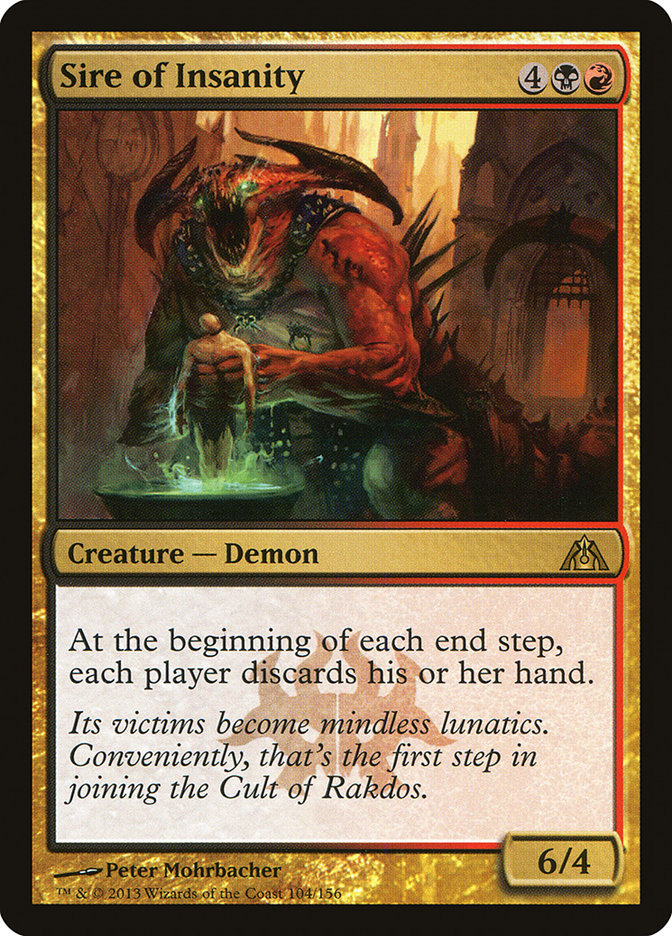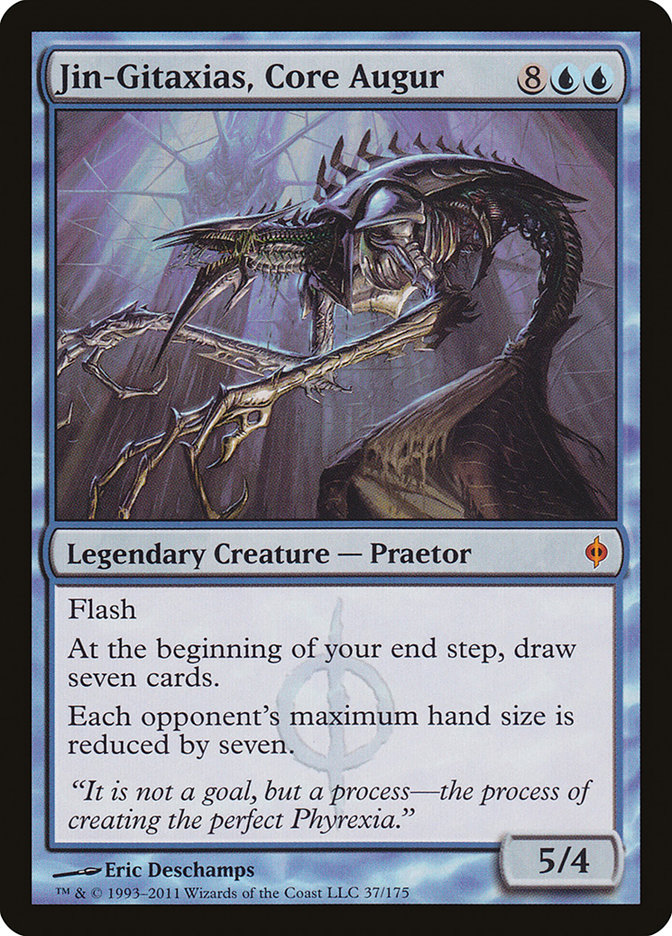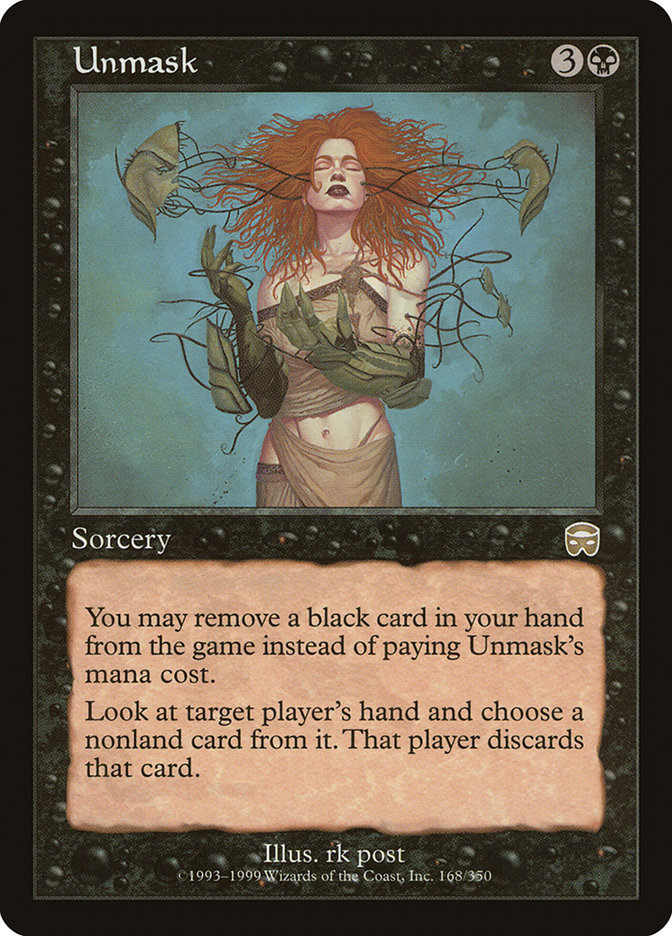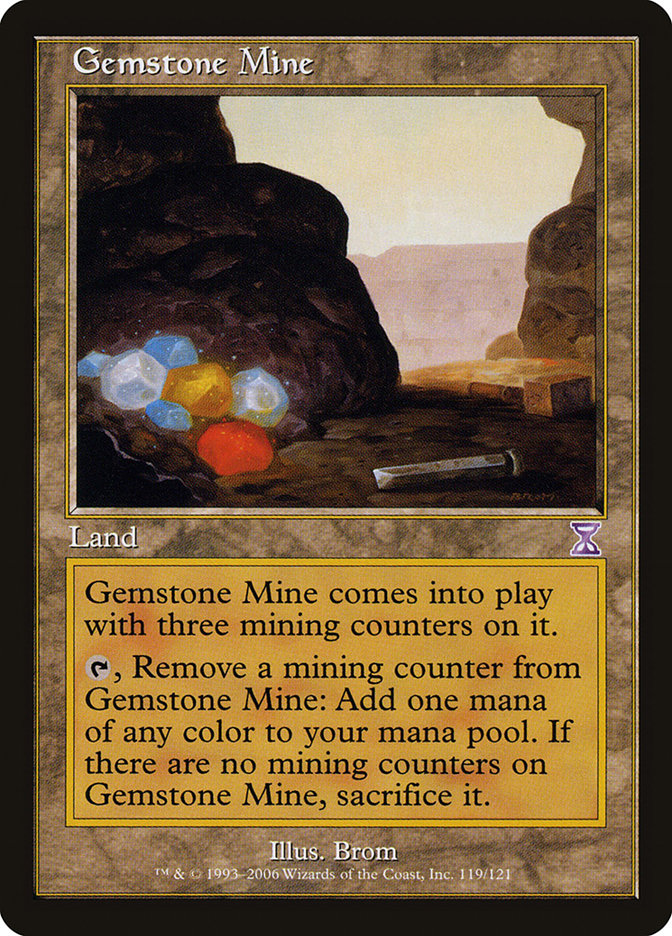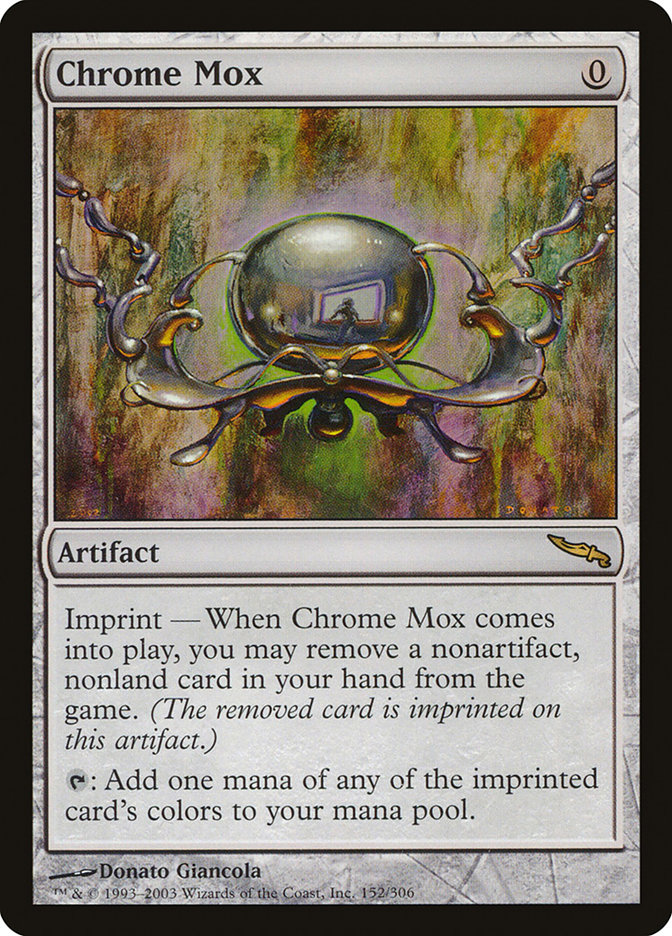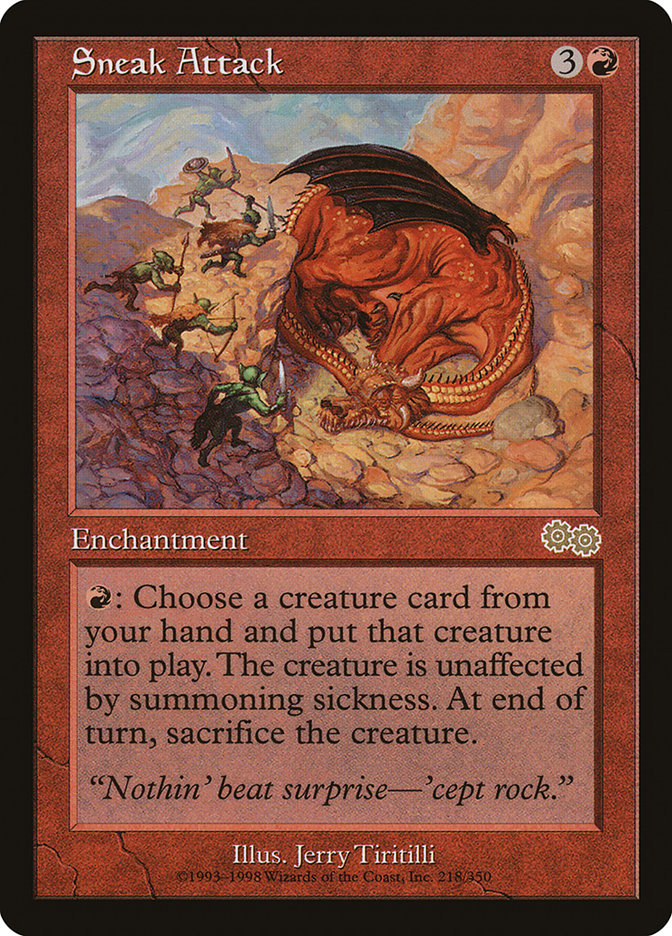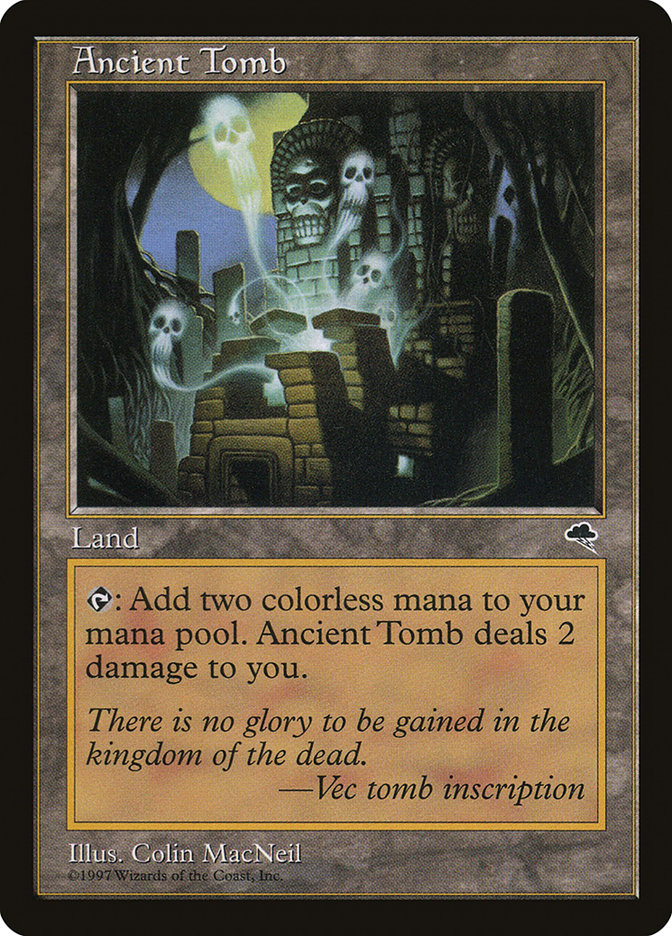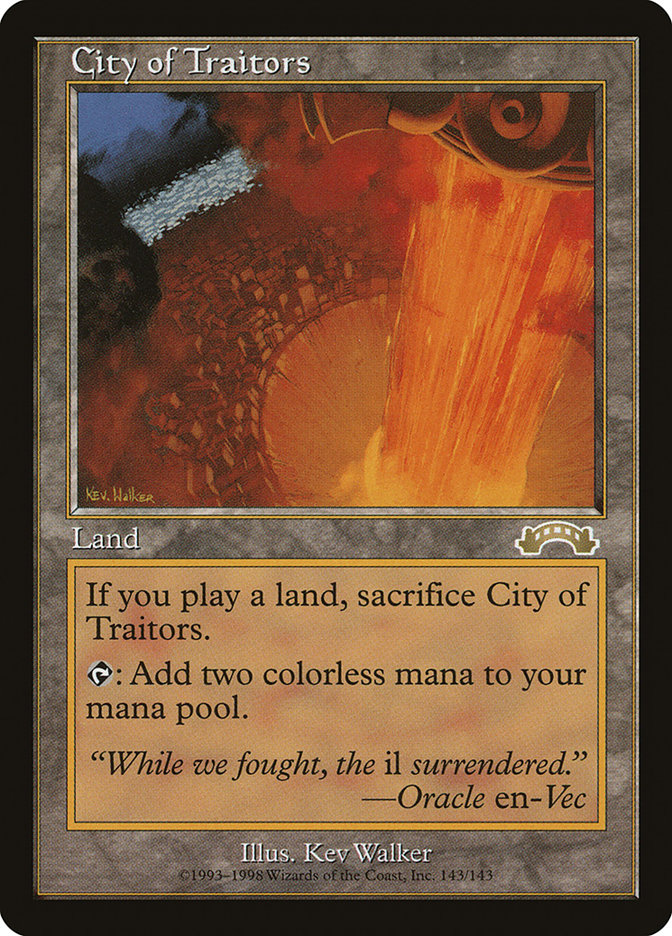It was just another Sunday at the SCG Open in Somerset, New Jersey, when Andrew Shrout and I started chatting.
He then showed me this deck:
Creatures (9)
- 1 Simian Spirit Guide
- 1 Iona, Shield of Emeria
- 2 Jin-Gitaxias, Core Augur
- 4 Griselbrand
- 1 Sire of Insanity
Lands (13)
Spells (38)

I’ve never been more excited about a Legacy deck. Like, ever.
The more we talked about it, the more I wanted to play it. I couldn’t even completely grasp all that this deck was doing, but I was already sold when I saw
the one Sire of Insanity.
Those Europeans sure do know how the meaning of “no fear!”
When I got home, I went to find more information about the deck only to come up with nothing aside from Carsten Kotter’s article a couple of weeks ago. This gave
me a pretty basic understanding of just how high-powered and resilient the deck can be, and I just couldn’t resist working on it more. There was a lot of
skepticism among my peers about the deck, and rightfully so, but I was really set on making it work. I didn’t really care if it wound up being a worse
version of something else anyways. Legacy, at least to me, is about doing cool and sweet things, and this deck exemplifies that in its entirety.
One of the issues with a deck like Omni-Tell, my combo deck of choice, is how reliant it is on vulnerable permanents like Omniscience and Dream Halls.
Often times, other Griselbrand combo decks will simply let your Show and Tell resolve, bring in their own Griselbrand, and if they have access to
countermagic, counter your Enter the Infinite or Cunning Wish, and you’re just dead on the spot. Non-combo blue decks can hold the fort in a very strong
way now with a plethora of soft and hard countermagic, on top of things like discard if they’re in black, additional counterspells if they’re in red, and a
high amount of pressure if they’re in green or white. In fact, this has been a running theme in recent Legacy history when it comes to blue combo versus
blue non-combo decks. It was difficult for me to play either side, as I just wanted to jam as hard as possible, but until this deck, there was no real way
of doing that without playing blue. Burning Reanimator changes that dynamic in a drastic, yet incredibly subtle way.
At its core, your plan A is to get a ridiculously large creature onto the battlefield as quickly as possible, using combinations like Dark Ritual into
Entomb and Exhume, land and Lion’s Eye Diamond and Unburial Rites, Burning Wish and Reanimate, or any combination among those you can figure out. It
wouldn’t do it justice to call your second plan a backup plan or a plan B, so we’ll just call it your second plan A, which is to kill them on the spot with
Griselbrand, fourteen cards, and a potentially lethal Tendrils of Agony or Empty the Warrens, or even another reanimated creature. This is a lot harder to
do than a traditional Storm deck, as you don’t have the blue cards to really sculpt a hand on your terms. Griselbrand is the replacement for this if you
decide to get them dead, and with Lion’s Eye Diamond and Lotus Petal, you at least have another shot at repeating the first plan A and getting a Jin
Gitaxias or Elesh Norn.
Your actual plan B is to Storm them out the hard way. This isn’t the prettiest or most elegant plan, and often times you can’t get within Tendrils range,
but Empty the Warrens is perfectly fine in those situations. Even making something like eight of ten goblins will be enough against some decks, and it
makes for a pretty good angle when everyone’s trying to kill your big guys.
If none of those plans work (which theoretically could happen), then pushing “the red button” may be in order. The red button is one of those last-ditch
efforts that can also be a feasible angle in non-dire situations. The red button is ramping into a Griselbrand and hoping for the best. This isn’t too
outlandish of a plan, as Dark Ritual and Lotus Petal can reasonably get you there, but it’s not something I see myself doing often unless we’re hit hard by
graveyard hate, and we can’t find the right pieces to deal with it or storm them out. The great thing about all of these gameplans is how each card is an
eligible contributor to most of your primary game plans. The intertwining pieces allow for little awkwardness with the flow of whichever direction a given
game takes you. Being able to use the same cards in different ways within the shell of your deck is something that very few unfair Legacy decks can
accomplish, with Elves being the most popular one I can think of.
Why play this over your standard, run of the mill U/B Reanimator?
U/B Reanimator boasts the power of Brainstorm, Ponder, Force of Will, and Daze to maximize efficiency and resilience, and it has proven for years that it
works. With that, I think it’s wrong to think of either deck as necessarily better than the other. Each deck tries to carry out a similar gameplan.
However, each of the given paths the two decks have available are dramatically different. Often times, you’ll see U/B Reanimator jam a reanimation spell
with countermagic backup, and if it works, then you’re usually golden. Burning Reanimator attempts to jam a threat, and if it doesn’t work, then you jam
again, and again, and again until it eventually works. This works as a primary because of how efficient Unburial Rites is, and how easy it is to get to
five mana in this deck. You can keep throwing spells in your opponent’s face until something works without much worry of bottoming out. Another selling
point is how little you really have to “sculpt” a gameplan due to the aforementioned intertwining pieces to your puzzle. Your graveyard is not only your
path to victory, but a resource as well because of Unburial Rites, something that U/B Reanimator doesn’t have access to. Your chance of getting them dead
on Turn 1 is also quite a bit higher, as the explosiveness of Dark Ritual and Lion’s Eye Diamond is unmatched. Burning Wish allows for even more utility
options as well as being a tool to assist said explosiveness when you don’t have access to a maindeck reanimation spell (while also being a direct win
condition itself via Storm cards).
U/B Reanimator is much better at attacking with a reanimated creature in most cases. This is because they can counter any sort of reactive spell via
drawing seven with Griselbrand. If they deal with our threat, then we have to do it again next turn, which is fine, but isn’t really gaining any sort of
traction. This is especially noticeable against decks like UWR Delver, where a single Swords to Plowshares could easily blow up our plan. In situations
like that, drawing seven or fourteen cards is much more risky, as you don’t really have a reactive spell for their reaction. This is also evident against
decks that can easily turn one you, like…U/B Reanimator! While there is definitely more play to the match than it seems, being on the draw hurts a lot
here. Your best bet is to stick a Sire of Insanity as best as possible before they attack you to death, and when you have to fight through about
twenty-one, sometimes twenty-eight cards, it may not always go according to plan. On the play, however, it is drastically different, as Sire of Insanity
does a great job of blanking a Griselbrand, while hardly hurting you. Thoughtseize and Unmask are also essential, but that is true against most unfair
decks. Iona and Jin-Gitaxias are also very powerful against Reanimator, and setting up a Tendrils of Agony for a large non-lethal amount is also within the
realm of possibility. You aren’t as high variance as Reanimator, and your resilience is on a different angle (instead of countermagic and Brainstorm, you
just continue pushing with a single Unburial Rites until something works), but you’re definitely lacking in the traction department when you don’t have a
threat on the board. Not necessarily all or nothing; more like an “Are we there yet? Are we there yet?” motion.
What about Tin Fins? Are you essentially doing the same thing, but worse?
The big difference between Burning Reanimator and Tin Fins is timing. You aren’t really forced to get things done in a single turn by nature of Goryo’s
Vengeance and Shallow Grave. Tin Fins is also a one trick pony, lacking the versatility and ability to change angles on the fly in its current iteration
(though that pony is extremely powerful and will kick you to the moon if you let it!). The timing alleviation allows you to develop a gameplan without
going all-in on it at a specific time. While Brainstorm mitigates this issue (shows how powerful Brainstorm is at…well…everything), Lion’s Eye Diamond
makes things so much easier as well, effectively becoming a Black Lotus in this deck. You also don’t have to play combo pieces that aren’t completely dead
outside of your primary plan. Children of Korlis allows for some real busted interactions and plays, but doesn’t really help much outside of one or two
spots. Once Tin Fins gets going, it will run you over. Burning Reanimator will keep trying to outmuscle you until you tap out.
Tin Fins is a muscle car. Burning Reanimator is a monster truck.
Card choices and interactions:
Disclaimer: I am no expert on the deck, but I’ll share everything I
‘ve learned so far. If you find any other interactions, please do let me know!
Your redundancy is the name of the game, which is important in a combo deck without Brainstorm. Your essentials are as follows:
Creatures:
4 Griselbrand: The best creature to cheat into play in the format. Period. We all know how powerful it is, so not much explanation is needed here. Run
four, and never, ever look back.
1 Iona, Shield of Emeria: There are plenty of decks that simply cannot beat this card. Being a 3- turn clock doesn’t hurt either. A great tool to have in
the maindeck, and also one of the easiest ways to get free wins against decks that aren’t prepared to beat it.
2 Jin-Gitaxias, Core Augur: Griselbrands number five and six, but also effective against opposing Griselbrands. You want Jin against other decks trying to
cheat the demon onto the battlefield and against Storm-based decks. Delver decks also have a hard time beating it, but you generally would rather have a
Griselbrand or Iona first.
1 Sire of Insanity: One of the only creatures in Legacy that not only cripples Delver and other fair decks to irreparability if brought out early, but like
Jin-Gitaxias, is highly effective against an opposing Griselbrand. This is your primary target if you can get it out on Turn 1 or 2 against non-blue decks
(if Swords to Plowshares isn’t present), and is the best tool you can have when you’re looking to hardcast an Unburial Rites. This is also one of the few
creatures you can actually hardcast when you’re in a pinch, and isn’t outside of feasibility when you’re given access to Dark Ritual and Lotus Petal.
1 Simian Spirit Guide: A flex slot, and your additional land for when trying to push a spell through, or for paying for a Daze. This can be a fourteenth
land if you want it to be, but it’s a matter of preference. It’s hard to justify two, but more testing is needed to draw that conclusion.
Spells:
4 Dark Ritual: One of the easiest ways to ramp almost anything out as quickly as possible. Dark Ritual plays a crucial role at almost all points of the
game. In fact, I don’t think I’ve ever seen Dark Ritual as versatile as it is in this deck. It enables everything, from Turn 1 reanimation plays, to Turn 1
Unmasks, to hardcasting Griselbrand, to helping sidestep Spell Pierce.
4 Entomb: A staple of any reanimator deck by now. While Entomb is obviously powerful in U/B Reanimator shells, it could only really get the creature piece
of the puzzle. Here, you can grab an Unburial Rites, further pushing its power, and even more importantly, the deck’s explosiveness and ability to win out
of nowhere.
3 Gamble: More tutors can’t hurt, and Gamble is the next best option. There aren’t many situations where casting Gamble will harm you, with an Exhume line
being the only one I can think of (and in that case, you can keep as many cards in your hand as possible to reduce the chance). You can also do tricks like
holding priority and pitching your hand via Lion’s Eye Diamond to get an Unburial Rites (assuming you have another mana source to cast the Rites, of
course).
3 Unmask, 4 Thoughtseize: Your discard package. The four Thoughtseize is essential, as it’s not only your primary way of keeping your opponent off balance,
but it’s yet another way to get creatures into your graveyard. Unmask is particularly useful because you can trade an excess card for a Thoughtseize
effect, as well as making Dark Ritual not as wasteful in certain situations.
4 Burning Wish: One of the most important cards in the deck, as it fills multiple crucial roles. Burning Wish functions as reanimation spells nine through
twelve, with Reanimate and Stitch Together in the sideboard. You can Reanimate your opponent’s creature with Reanimate in the same fashion. It’s a sweeper
against Maverick/Death and Taxes-style decks, as well as white Delver decks and Elves (if you can get to that amount of mana quickly). It’s a way to
pseudo-Show and Tell against creatureless decks with Stronghold Gambit (or if your opponent has no creatures in their hand via finding out with a discard
spell). It’s an additional discard spell in a pinch with Cabal Therapy, and it’s the direct enabler of your “Storm them out” plan.
4 Exhume, 4 Unburial Rites, 0 Reanimate: Exhume and Unburial Rites are the most efficient ways you can get something into play quickly. This is because of
how Lion’s Eye Diamond functions in this deck. With Exhume, you can cast it, hold priority and dump your hand, or Dark Ritual into
Entomb/Unmask/Thoughtseize and Exhume, among many, many other angles. Unburial Rites is the primary way you can push through countermagic so well, and is
also the big reason why Lion’s Eye Diamond works so well in this deck. If you know your opponent is playing blue, then you can simply push for a longer
early game and hardcast Unburial Rites into the face of a Force of Will or other counterspell and still have another shot at it next turn (sometimes in the
same turn!). The demand to answer the Unburial Rites and have something in between to cast for next turn cycle is very difficult for a lot of
decks, and there are so many ways of enabling the maximization of every piece surrounding Unburial Rites that one single answer may not be enough.
Reanimate doesn’t quite work out in this deck for a couple of reasons. Firstly, it hurts. A lot. Reanimating a Jin-Gitaxias or Griselbrand could very
easily get you killed here, especially since you don’t have reactive countermagic to reinforce your board presence. Secondly, it doesn’t really play nicely
with how you’re trying to reanimate anyway, as you can’t really use it with Lion’s Eye Diamond or Entomb. The lack of cross-synergy takes away from its
effectiveness greatly.
4 Lion’s Eye Diamond: As previously said, LED is basically Black Lotus here. The amount of powerful interactions you can do is often enabled by this card,
and I’d go as far as to say that it’s the most important and most powerful card in the deck. It’s the reason why Unburial Rites and Exhume (to a slightly
lesser extent) function the way they do, and it’s why you can take a page out of Storm’s book and Tendrils of Agony or Empty the Warrens as well. The role
LED fills simply cannot be matched, and I wouldn’t even think about cutting it, ever.
4 Lotus Petal: Most unfair decks that want to maximize explosiveness will run a high number of Petals. Petal is also important because it helps you play
around Daze, a counterspell that hurts us a lot. While it’s the weakest of our three ramp spells, it can still mean the difference between going off on
Turn 1-2 and not going off at all.
Manabase: This was overlooked by me when I first went to tackle this deck, but Carsten pointed it out in a comment in his article:
“The perfect fetches for this deck are probably either blue ones (to fake countermagic on t1) or Bloodstained Mire/Verdant Catacombs (if you fetch
those into Badlands, Thoughtseize, I’m putting you on Jund, not Reanimator) or Marsh Flats (Marsh Flats -> Scrubland -> Thoughtseize =
DeathBlade). Anything that makes you look like a grindy fair deck on t1 has to be perfect here.”
I knew that this was a thing since Wooded Foothills in RUG Delver (and probably before that), but I was completely blown away by how much this matters in
this deck, and you can often get some very easy wins from this alone. I’d go as far as to say that the amount that something like this matters is more
apparent than in any other deck in Legacy, especially if this deck doesn’t become a known quantity for a while.
Sideboard:
Your sideboard is mostly a wishboard, but with cards that are also available to put in the maindeck. With three Empty the Warrens and Stronghold Gambit,
you can very easily side two in where applicable, and leave the last one for Burning Wish. It’s also not out of the question to sideboard out some number
of Unburial Rites against graveyard hate and kill them via one of those two options. Stronghold Gambit works especially well because of how well you can
position it to make sure you get your creature on the board. Delver decks are usually light on creatures and/or want to play all of them anyway, and if I
didn’t have a discard spell, I’d be more than happy with jamming a Gambit against them most of the time. If I do have a discard spell, things change
greatly. You can take the counterspell that would be useful to counter your Gambit, and sort-of “level” your opponent when they play that one creature in
their hand. Or just take the creature, get your Gambit countered, and try to win some other way. Reanimate and Stitch Together is there to supplement
Burning Wish, as one is a more explosive option, and the other benefits from the slower games. Unmask and Cabal Therapy are essential to have when you need
a way to make sure the coast is clear before proceeding. Massacre is pretty self-explanatory, as is Meltdown. Finally, Ashen Rider and Elesh Norn are
additional tools against unfair and fair matchups, respectively.
Other choices and options:
Suggested by Ari Lax, Gemstone Mine is a nice inclusion to the manabase. You can shave a fetch land or two, reducing your likelihood to get Stifled out of
a game, and some dual lands, which have almost no effect. The ability to only use it three times shouldn’t hurt us in the long run, but practice will tell
if that’s actually true.
If Chrome Mox is included, it’ll probably take Simian Spirit Guide’s spot, which is totally fine to me. The ability to have yet another Lotus Petal effect
that also adds to your storm count is pretty good.
If you’re really looking for a Brainstorm effect in this deck, this is it. You’ll often find yourself in situations where you just need to draw gas, and
Faithless Looting is the exact card I’d play if you can find the room for it. This also adds even more options for Lion’s Eye Diamond.
I’m a pretty big fan of Sneak Attack in the sideboard. You’re trading the flexibility of your Burning Wish for another way to sidestep the hate against
you, which is always a good thing in my book.
Sol lands seem pretty dang attractive in this shell, but unfortunately, you’re way too mana intensive to really make it happen. You have enough
acceleration in Petal, LED, and Dark Ritual, and you really can’t afford to lack a color on the critical turn.
How does this deck beat graveyard hate?
Since there are a ton of ways to get through on turn one, beating a Deathrite Shaman isn’t all that outlandish on the play. The problem is when you’re met
with Deathrite Shaman in addition to countermagic, discard, and/or any other sort of disruption. Things get very challenging there, and you’ll have to get
creative to break out. Exhume (holding priority) and cracking LED with two or more creatures is one way. The aforementioned Burning Wish into Stronghold
Gambit if you can catch them with no creatures is another. Sideboarding into your Storm cards and hardcasting a Griselbrand or Sire of Insanity are both
perfectly fine ways of getting through as well. Post-board, you’ll see a lot more hate, which is where I’m a big fan of cards like Sneak Attack. I’d
consider running some number of those if you’re that worried about it.
What about Thalia?
Thalia is probably the deck’s biggest weakness, and you can very easily die to one if you’re caught with a shaky hand. The best way to beat a resolved one
is to focus your gameplan toward resolving a Massacre. Of course, this is easier said than done, since Rishadan Port, Wasteland, and clocks like
Batterskull, Brimaz, King of Oreskos, and the like make life incredibly difficult. Maverick can Gaddock Teeg you out, which is the absolute worst when
combined with Thalia, and there isn’t really a way to get around that other than trying to reanimate as best as possible. In fact, I’d say that Maverick is
one of your worst matchups by far because of those two cards.
I want to change (x) card.
I highly recommend not changing anything until you can figure out as many ins-and-outs beforehand. While this is a pretty sweet deck to pick up and jam,
this is by no means an easy deck to master. The amount of nuance is not to be underestimated, and I wouldn’t risk trying to mess with that until the
understanding of what’s going on is met with certainty. There are a ton of things I want to try, like touching blue for a Show and Tell to wish for, but
every time I do, something very “off” happens, and I just go back to where I started. There’s so much to learn here that I think that very little will
change going into the SCG Open in Providence this week.
Legacy is now exciting to me again, and I think I’ve found a deck that I can really call my own. I’d be lying to you if I said I was expecting something
like this to interest me, but sometimes great things come from the most unexpected places. This is completely out of my wheelhouse, but I don’t think I can
get away from something so innovative and fun. It hasn’t caught on yet here in the Northeast, but I plan on leaving a mark with this and collecting match
slips, one Unburial Rites at a time.

